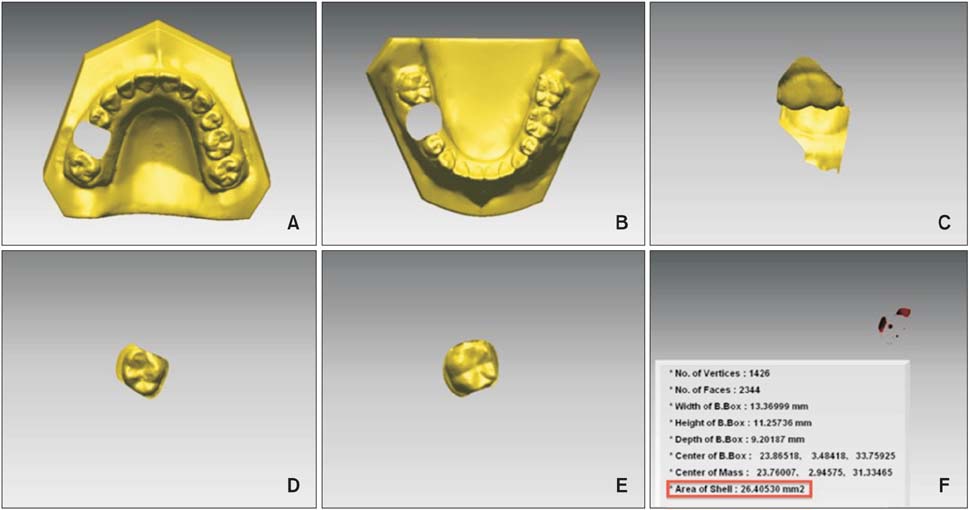Korean J Orthod.
2015 May;45(3):113-120. 10.4041/kjod.2015.45.3.113.
Comparison of occlusal contact areas of class I and class II molar relationships at finishing using three-dimensional digital models
- Affiliations
-
- 1Department of Dentistry, Graduate School of Medicine, Ewha Womans University, Seoul, Korea. Yschun@ewha.ac.kr
- KMID: 1974802
- DOI: http://doi.org/10.4041/kjod.2015.45.3.113
Abstract
OBJECTIVE
This study compared occlusal contact areas of ideally planned set-up and accomplished final models against the initial in class I and II molar relationships at finishing.
METHODS
Evaluations were performed for 41 post-orthodontic treatment cases, of which 22 were clinically diagnosed as class I and the remainder were diagnosed as full cusp class II. Class I cases had four first premolars extracted, while class II cases had maxillary first premolars extracted. Occlusal contact areas were measured using a three-dimensional scanner and RapidForm 2004. Independent t-tests were used to validate comparison values between class I and II finishings. Repeated measures analysis of variance was used to compare initial, set up, and final models.
RESULTS
Molars from cases in the class I finishing for the set-up model showed significantly greater contact areas than those from class II finishing (p < 0.05). The final model class I finishing showed significantly larger contact areas for the second molars (p < 0.05). The first molars of the class I finishing for the final model showed a tendency to have larger contact areas than those of class II finishing, although the difference was not statistically significant (p = 0.078).
CONCLUSIONS
In set-up models, posterior occlusal contact was better in class I than in class II finishing. In final models, class I finishing tended to have larger occlusal contact areas than class II finishing.
Keyword
MeSH Terms
Figure
Cited by 2 articles
-
Comparison of masticatory efficiency according to Angle's classification of malocclusion
Jungin Bae, Woo-Sung Son, Seong-Sik Kim, Soo-Byung Park, Yong-Il Kim
Korean J Orthod. 2017;47(3):151-157. doi: 10.4041/kjod.2017.47.3.151.Posterior dental compensation and occlusal function in adults with different sagittal skeletal malocclusions
Soonshin Hwang, Yoon Jeong Choi, Sooin Jung, Sujin Kim, Chooryung J. Chung, Kyung-Ho Kim
Korean J Orthod. 2020;50(2):98-107. doi: 10.4041/kjod.2020.50.2.98.
Reference
-
1. Liu D, Melsen B. Reappraisal of Class II molar relationships diagnosed from the lingual side. Clin Orthod Res. 2001; 4:97–104.
Article2. Wheeler RC. An atlas of tooth form. Philadelphia: WB Saunders;1969.3. Casko JS, Vaden JL, Kokich VG, Damone J, James RD, Cangialosi TJ, et al. Objective grading system for dental casts and panoramic radiographs. American Board of Orthodontics. Am J Orthod Dentofacial Orthop. 1998; 114:589–599.4. Fotis V, Melsen B, Williams S. Posttreatment changes of skeletal morphology following treatment aimed at restriction of maxillary growth. Am J Orthod. 1985; 88:288–296.
Article5. Jang SY, Kim M, Chun YS. Differences in molar relationships and occlusal contact areas evaluated from the buccal and lingual aspects using 3-dimensional digital models. Korean J Orthod. 2012; 42:182–189.
Article6. Gibbs CH, Mahan PE, Lundeen HC, Brehnan K, Walsh EK, Holbrook WB. Occlusal forces during chewing and swallowing as measured by sound transmission. J Prosthet Dent. 1981; 46:443–449.
Article7. Yoon HR, Choi YJ, Kim KH, Chung C. Comparisons of occlusal force according to occlusal relationship, skeletal pattern, age and gender in Koreans. Korean J Orthod. 2010; 40:304–313.
Article8. Yurkstas A, Manly RS. Measurement of occlusal contact area effective in mastication. Am J Orthod. 1949; 35:185–195.
Article9. Garrido García VC, García Cartagena A, González Sequeros O. Evaluation of occlusal contacts in maximum intercuspation using the T-Scan system. J Oral Rehabil. 1997; 24:899–903.
Article10. Angle EH. Classification of malocclusion. Dental Cosmos. 1899; 41:248–264. 350–357.11. Hellman M. An interpretation of angle's Classification of malocclusion of the teeth supported by the evidence from comparative anatomy and evolution. Dental Cosmos. 1920; 62:476.12. Jang JM, Lee SB. A qualitative and quantitative study on occlusal conditions in health volunteers and athletes with normal occlusions. J Adv Prosthodont. 1998; 36:302–322.13. Ehrlich J, Taicher S. Intercuspal contacts of the natural dentition in centric occlusion. J Prosthet Dent. 1981; 45:419–421.
Article14. Delong R, Ko CC, Anderson GC, Hodges JS, Douglas WH. Comparing maximum intercuspal contacts of virtual dental patients and mounted dental casts. J Prosthet Dent. 2002; 88:622–630.
Article15. Kim JH, Kim KB, Kim WC, Kim JH, Kim HY. Accuracy and precision of polyurethane dental arch models fabricated using a three-dimensional subtractive rapid prototyping method with an intraoral scanning technique. Korean J Orthod. 2014; 44:69–76.
Article
- Full Text Links
- Actions
-
Cited
- CITED
-
- Close
- Share
- Similar articles
-
- Differences in molar relationships and occlusal contact areas evaluated from the buccal and lingual aspects using 3-dimensional digital models
- A study on the second molar which was malpositioned after orthodontic treatment
- Full mouth rehabilitation of skeletal class II patient with regaining occlusal vertical dimension: a case report
- A study of the etiology of unilateral Class II, division 1 malocclusion
- Posterior dental compensation and occlusal function in adults with different sagittal skeletal malocclusions




